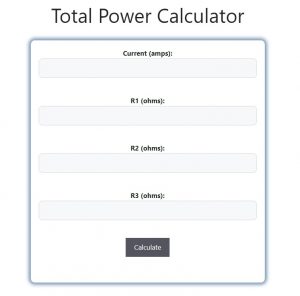About Total Power Calculator (Formula)
The Total Power Calculator is an essential tool for anyone working with electrical circuits, enabling users to quickly determine the total power consumption based on the current and resistance values. Understanding total power is crucial for designing efficient electrical systems, ensuring safety, and optimizing performance. In this article, we will explore the formula, how to use the calculator, provide an example, answer common questions, and conclude with the significance of accurately calculating total power.
Formula
The formula to calculate total power (Pt) is:
Total Power (Pt) = I² * (R1 + R2 + R3)
Where:
- Pt is the total power in watts.
- I is the current in amperes.
- R1, R2, and R3 are the resistances in ohms.
How to Use
Using the Total Power Calculator is straightforward. Here’s a step-by-step guide:
- Measure the Current (I): Determine the current flowing through the circuit, usually measured in amperes (A).
- Identify the Resistances (R1, R2, R3): Identify all the resistances in the circuit. Ensure these are measured in ohms (Ω).
- Input Values: Enter the current value (I) and the resistance values (R1, R2, R3) into the formula.
- Calculate: Use the formula to compute the total power, ensuring that you have the correct units for current and resistance.
Example
Let’s say you have a circuit with a current of 5 A and three resistances: R1 = 4 Ω, R2 = 6 Ω, and R3 = 2 Ω.
- Insert these values into the formula:
- Total Power (Pt) = 5² * (4 + 6 + 2)
- Total Power (Pt) = 25 * 12
- Total Power (Pt) = 300 watts
In this example, the total power consumed by the circuit is 300 watts.

FAQs
- What is total power in an electrical circuit?
- Total power refers to the amount of electrical energy consumed by the circuit, measured in watts.
- Why is it important to calculate total power?
- Calculating total power helps ensure that electrical components are adequately rated and prevents overheating or failure.
- What units are used for measuring power?
- Power is measured in watts (W).
- Can the Total Power Calculator be used for AC circuits?
- Yes, but for AC circuits, additional factors such as power factor need to be considered.
- What happens if the total power exceeds the circuit’s capacity?
- Exceeding the circuit’s capacity can lead to overheating, tripping circuit breakers, or causing damage to components.
- How can I convert power from watts to kilowatts?
- To convert watts to kilowatts, divide the power value by 1,000 (1 kW = 1,000 W).
- What is the relationship between power, current, and resistance?
- Power is directly proportional to the square of the current and the total resistance in the circuit.
- Is it necessary to measure each resistance individually?
- If resistances are in series, you can sum them up. If they are in parallel, you will need to calculate the equivalent resistance.
- How can I reduce power consumption in a circuit?
- You can reduce power consumption by using higher resistance values or reducing the current flowing through the circuit.
- What safety precautions should I take when calculating total power?
- Always ensure the circuit is de-energized before making measurements, and use appropriate protective gear.
- Can I use this calculator for complex circuits?
- For complex circuits, additional calculations may be necessary, but this formula can provide a good estimate.
- How do temperature changes affect resistance and power?
- Resistance can change with temperature, typically increasing with higher temperatures, which can affect total power calculations.
- What are common applications of the Total Power Calculator?
- It is used in electrical engineering, appliance ratings, circuit design, and energy audits.
- Are there online tools for calculating total power?
- Yes, there are many online calculators available that can simplify this process.
- What is the difference between total power and reactive power?
- Total power is the real power consumed, while reactive power is the power that oscillates between the source and load, not consumed as useful work.
- How often should I calculate total power in existing circuits?
- It’s advisable to perform calculations whenever modifications are made to the circuit or during routine maintenance checks.
- What should I do if I’m unsure about the resistance values?
- Use a multimeter to measure the resistance of each component directly.
- How does the load affect total power?
- The load determines the current flowing through the circuit, directly impacting the total power consumed.
- Can I use the Total Power Calculator for renewable energy systems?
- Yes, it can be applied to assess power consumption in solar or wind energy systems as well.
- Is there a relationship between power factor and total power?
- Yes, the power factor affects the real power consumed in AC circuits and is a ratio of real power to apparent power.
Conclusion
The Total Power Calculator is an invaluable resource for anyone involved in electrical work, helping to ensure that circuits are designed and maintained for optimal performance. By understanding how to apply the formula and interpret the results, users can make informed decisions about their electrical systems, improving safety and efficiency. With accurate calculations, engineers and technicians can enhance the reliability and effectiveness of their designs, ultimately contributing to the successful operation of electrical circuits.
